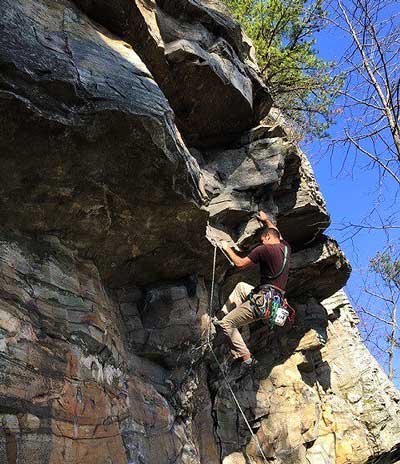Is igneous bliss or are all the little sediments of rock knowledge metamorphosing climbers into rock experts? Ha!
As rock climbers, we experience many different types of rocks when we go to climb at various crags all over Southern California. Many climbers don’t even think twice about the differences between these rocks, much less the names and properties of them, although it might prove useful. The physical differences between each type of rock can help a climber greatly!

Two related classes at High Trails – Climbing and Earth Works.
 Three Types of Rock
Three Types of Rock
As you might learn in an Earth Works class at High Trails, there are three main types of rock: Igneous, Metamorphic, and Sedimentary.
- Igneous rock is formed from magma that has been cooled.
- Metamorphic rock is formed by the heat and pressure from being buried so deep in the earth. You can think of metamorphic rock as being squeezed together and baked at the same time underground.
- Sedimentary rock is formed by little pieces of sand or mud laying on top of each other, also called deposition, and then solidifying.
The geology of southern California is so diverse that you can find and climb on many different types of igneous and sedimentary rocks within a six hour drive from High Trails! Metamorphic rocks are a little further away from southern California and a little harder to find (this is due to localized areas of heat and pressure), but are still very fun to climb! Different textures and hardness of each type of rock can have pros and cons to a rock climber.
Sedimentary
One example is the sedimentary sandstone found in St. George, Zion National Park, and Moab, Utah. This sandstone can have very good grip, but if it has rained recently the surface of the sandstone becomes softer. This causes erosion, leaving a thin outer- layer of fine sand on the rock that can be slippery after it has dried. As climbers who use this rock, it is our job to protect it as well by not climbing on it at least three days after heavy rain. That way, we don’t break or wear down the rock because it is softer when it is wet.

Sandstone Cracks.
Igneous
Other places, like Joshua Tree National Park, have monzogranite, a type of igneous rock that has very good grip because of the small, sharp crystals that make up its surface. These crystals give a climber’s rubber shoe lots of friction which helps them climb their way up a rock. The bad part is, these crystals can sometimes crumble under the weight of a climber and cause the climber to slip. The massive granite domes of Yosemite National Park are also igneous rocks and have similar characteristics for climbers.

Bouldering in Joshua Tree
Metamorphic
As for metamorphic rock, it is a bit more difficult to find in California in large quantities like igneous and sedimentary rock. This is because it is usually found in localized pockets of immense heat and pressure, like tectonic plate boundaries. One place you can find it, though, is in the local desert climbing area New Jack City, or Sawtooth Canyon.
While metamorphic rock may not be abundant in California however, there are many places that offer opportunities to climb the extremely hard and sometimes slick metamorphic rock. Places like Utah’s Big Cottonwood Canyon and Colorado’s Clear Creek Canyon have plenty of quartzite, gneiss, and schist formations to be climbed.

Ahhh…New Jack

The Author on a Rock.
Ahh…New JackAlso, most of the rock formations in North Carolina are indeed metamorphic, which is where I first learned to climb! Metamorphic rock is notorious for being somewhat slippery for a climber’s shoe, but climbers tend to find grip on many of the crystals that may be embedded in the rock.
As climbers, we can help ourselves by taking the time to learn about those rock formations that we love so much and choose to climb on. The way the rock was formed might mean the difference between a piece of rock either crumbling in a climber’s hand, or an edge of rock the width of a dime being able to hold the weight of many climbers for years to come. As stewards of these wonderful rock formations, it is also our responsibility to help preserve them from damages of any kind.
https://www.nps.gov/jotr/learn/nature/geologicformations.htm
http://www.rockclimbing.com/Articles/Geology_for_Climbers_Part_III_Metamorphic_Rocks_1595.html
http://www.dirtyclassroom.com/forms/dirtresources/earthworkslessonplan.pdf
At High Trails Outdoor Science School, we literally force our instructors to write about elementary outdoor education, teaching outside, learning outside, our dirty classroom (the forest…gosh), environmental science, outdoor science, and all other tree hugging student and kid loving things that keep us engaged, passionate, driven, loving our job, digging our life, and spreading the word to anyone whose attention we can hold for long enough to actually make it through reading this entire sentence. Whew…. www.dirtyclassroom.com

Comments are closed.